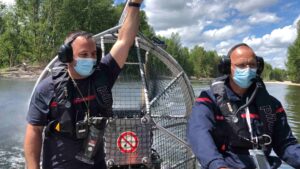First of all, choose your radio communication system.
Professionals working mostly in noisy (assembly, sorting, and manufacturing industries…) or critical environments (SEVESO site, mine clearing, civil security…) must have their 2 hands free and have permanent and open-microphone communication, without having to manipulate their radio device to speak or listen.
Full duplex systems meet these issues, unlike simplex systems, such as most walkie-talkies, where speaking requires the pressing of a button and only one person can speak at a time.
Nevertheless, the protocols, frequencies and technologies used by these full duplex systems do not allow them to carry over long distances like some walkie-talkies, which, despite all the advantages mentioned above and often also the audio quality, can transmit over a few tens of kilometers. A high-performance full duplex communication system will be able to operate up to 1 or 2 km away.
Then, you need to identify your work environment and how far you want to communicate.
Depending on your job, you can work in buildings with heavy concrete walls, underground, on different levels or between different buildings in a factory. The crossing of radio waves can be severely reduced or even impossible for radiocommunication systems.
Depending on your use case, you may need to set up wired solutions to ensure stable communication between all your users.
Several criteria will be important to decide which type of equipment will best fulfill this gateway function between your teams.
In particular, these include:
- The fact of being on a permanent installation such as an industrial site, for example, or something more temporary during an outdoor intervention.
- The distance between the different sub-groups you wish to link and the obstacles you will have to cross.
- The nature of your teams and the communication equipment they are equipped with. You will think differently if all the users are mobile and equipped with portable radios or if some of them are fixed with communication desks, as in a control room.
Find out what technical solutions currently exist and which one to choose:
By wired extension reel:
The wired audio extension reel, on which a radio terminal is connected at each end, is the perfect complement for mobile teams such as firemen or sewage workers who need to connect people who stay on the ground with those who work underground.
Once in the confined area, the crew members going into need only to deploy the terminal on the unwinding end of the reel with them to maintain contact with the surface.
In order to keep the equipment portable, thus allowing it to be used absolutely everywhere and quickly, the length of the cable can hardly exceed a hundred meters, which is more than sufficient for the use cases mentioned above.

By XLR cables:
XLR cables allow to connect two fixed radio relays, commonly called Gateway or Wireless Interface, with XLR analog inputs/outputs.
This type of installation, even if it is very simple to implement, is rather deployed for permanent use on site, when you want to connect two teams, equipped with mobile radios, separated by a few hundred meters (500 meters maximum to avoid excessive audio losses inside the cables).

By optical fiber:
In the same way as with XLR cables, a fiber optic network will be used to connect two Gateways or a Gateway and a desk installed in a control room, for example.
The main advantage of fiber over XLR cables is its ability to transport data, in this case digitzed audio, over longer distances. We can easily envisage ranges of over 5 km. Often industrial sites or sports arenas are already equipped with fiber optic networks that can be used for temporary or permanent installations.
By IP network:
When we talk about IP network, we are necessarily on an indoor installation, most of the time permanent. The use of the IP network makes it possible to link together as many desks or gateways as required, whatever their location on the site.
It has the major advantage of not having to pull cables and its installation can therefore be very simple as soon as the system adapts to the technical characteristics of the network.
The intervention of the network administrator may be required even though today some systems are becoming more and more plug&play.

